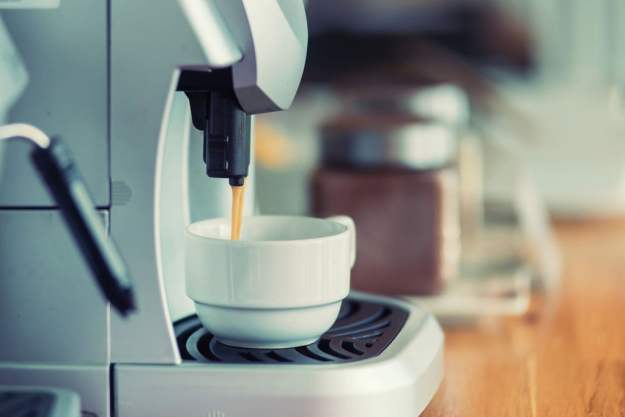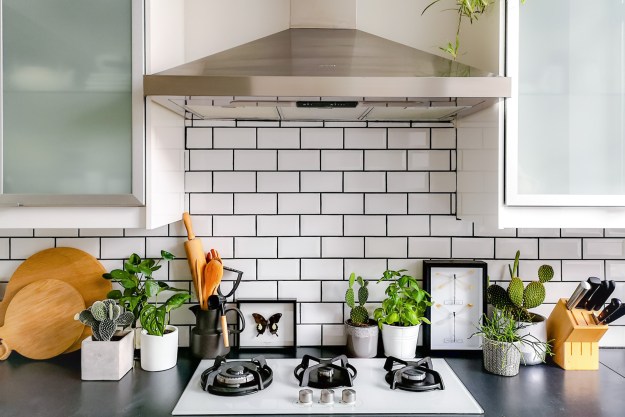Backyard swimming pools are a homeowner’s dream, and they definitely come in handy during scorching summers. Pools require a good amount of work, though, especially when you consider all the necessary upkeep like winterizing maintenance and summer cleaning. Having a pool that’s easy to clean is always a plus, and that’s why pools with tiling are so popular. Tiles are often used as flooring and in bathrooms because they're easy to clean, but scrubbing your shower is a bit different than sanitizing a pool. So what's the best way to clean pool tiles? We’ll walk you through how to refresh these tiles the right way so you can enjoy your luxurious, sparkling pool all summer long.

Why are those waterline tiles so dirty?
The area of tile right on the waterline tends to collect an unsightly, ghostly film due to a buildup of calcium deposits. This calcium carbonate buildup occurs when pool water evaporates and leaves behind the solid minerals. While this is a common condition for most backyard pools, excessive calcium deposits may be a sign of other underlying issues.
High levels of pH or alkalinity. If your pH levels are high or you have high alkalinity in your pool water, the chemicals cause the calcium carbonate to separate from the water, leaving it behind on your pool tiles.
Hard water. Hard water (water with a high concentration of dissolved minerals) can also leave behind high levels of calcium carbonate buildup on your pool tiles, ladders, and other surfaces. If this is the case, use a water softener to sift out the minerals or call an expert pool cleaner for help.
Long bouts of extreme heat. Since evaporation is the primary cause of calcium residue, hot weather is a big contributor. If you live in a region with high temperatures, your pool water will evaporate more quickly, leaving behind that pesky residue.
How do you clean pool waterline tiles?
Now that you know where that grime on the waterline is coming from, it's time to get rid of it. Let’s review a few of the most effective methods for getting those tiles sparkling clean. The approach you choose will depend on the severity of the calcium buildup.
Scrub it away by hand
For a light buildup of calcium across a small area, simply use a scrubbing tool to remove the grime.
Step 1: Grab a scrubbing brush, pumice stone, or even a toothbrush (if the area is small enough).
Step 2: Gently scrub a small area first to be sure the tool won’t scratch the tile surface.
Step 3: Once you’ve determined the tool is safe to use, get to work scrubbing away the visible calcium deposits.
Can you use vinegar to clean pool tile?
Scrubbing with water alone may not yield the best results. Plus, it takes quite a bit of time and effort. Instead, use vinegar to loosen up the grime before wiping it away. Vinegar is a great cleaning agent and it’s natural and chemical-free, so you don't have to worry about inhaling any noxious fumes.
Step 1: Mix equal parts vinegar and water.
Step 2: Dip your scrubbing brush or toothbrush into the mixture and then scrub the calcium deposits away.
Use a pressure washer
If the calcium buildup covers a significant area of your pool tiles, washing them by hand won't get the job done efficiently. For more widespread, stubborn buildup, bring out the pressure washer.
Step 1: Check your pool tiles first for any cracked or chipped pieces. Pressure washing could damage these broken tiles even more.
Step 2: Use the pressure washer on a very low setting to avoid chipping or damaging tiles.
Try a commercial pool tile cleaner
If your calcium buildup is thick and won’t come off completely with a pressure washer, you may need to use some stronger chemicals. Mixing water and muriatic acid can do the trick, but you can also use a cleaning product specifically formulated for pool tiles. Before you begin, read all the instructions thoroughly, keep pets and small children away from the pool, and follow all the recommended safety precautions.

Tips for keeping your pool tiles clean
Whether you clean by hand or with the help of a pressure washer, maintaining a spick and span pool is a lot of work. The last thing you want is to look at your pool a few months later just to see the buildup has returned worse than ever. Instead of deep cleaning multiple times a year, stick to a schedule of consistent, light pool maintenance.
Step 1: Monitor chemical levels in your pool closely to avoid imbalances in pH or alkalinity.
Step 2: Clean your pool regularly by keeping it free of debris and surface scum. Invest in a pool brush and give your tiles a monthly scrub to prevent buildup.
Having a swimming pool at your disposal makes those hot summer days bearable. However, no one wants to swim in a pool that’s grimy and slimy. Simply removing calcium deposits and cleaning the tiles regularly will ensure your pool is clean and pristine for the warm summer months ahead.
Editors' Recommendations
- How to clean oven racks the easy way
- 6 kinds of perennials that bloom in the summer for a gorgeous garden all season
- Avoid a huge fire risk in your home: How to clean your dryer vent
- How to get rid of that hideous water stain on the ceiling and beautify your home
- How to clean silver flatware so it sparkles



